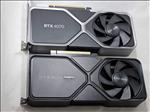
NVIDIA GeForce RTX 4070 Super
As usual, NVIDIA announced a few new video cards during CES and this year, it’s the Super line of cards. While three cards were announced, they are being released in stages and NVIDIA was kind enough to send over the first offering of the new year, the GeForce RTX 4070 Super, for us to test.
The GeForce RTX 4070 Super is built on the AD104 featuring the Ada Lovelace architecture. By now, we’ve been through a whole host of Ada Lovelace cards so you’ll probably know some of the features it contains such as support for Frame Generation and AV1 encoding among other things. Here’s a chart comparing the GeForce RTX 4070 Super with a few of the other cards in the 4070 line and how it lines up with the previous generation RTX 3070.

|
GeForce RTX 4070 Super |
GeForce RTX 4070 |
GeForce RTX 4070 Ti |
GeForce RTX 3070 Ti |
|
|
SM |
56 |
46 |
60 |
48 |
|
CUDA Cores |
7168 |
5888 |
7680 |
6144 |
|
Tensor Cores |
224 (4th gen) |
184 (4th gen) |
240 (4th gen) |
192 (3rd gen) |
|
RT Cores |
56 (3rd gen) |
46 (3rd gen) |
60 (3rd gen) |
48 (2nd gen) |
|
Texture Units |
224 |
184 |
240 |
192 |
|
ROPs |
80 |
64 |
80 |
96 |
|
Base Clock |
1980 MHz |
1920 MHz |
2310 MHz |
1575 MHz |
|
Boost Clock |
2475 MHz |
2475 MHz |
2610 MHz |
1770 MHz |
|
Memory Clock |
10500 MHz |
10500 MHz |
10500 MHz |
9500 MHz |
The RTX 4070 Super gets a few bumps over the RTX 4070 to make it a much speedier card. For starters, there are 7168 CUDA cores versus 5888 of the vanilla RTX 4070, a bump of almost 22% here.Tensor Cores and Texture Units are increased from 184 to 224. Streaming Multiprocessors also get a boost from 46 to 56. The base clock speed gets a slight bump at 1980 MHz but the same boost clock of 2475 MHz. Memory also stays the same with a total of 12GB of GDDR6X memory running at 10500 MHz on a 192-bit bus. I’m sure this is going to be harped on by a lot of people as we’ve seen a few games these days use more VRAM and seeing it the same here while the Ti Super gets a bump in VRAM is a little disappointing. So pretty much everything but the memory gets an increase from the RTX 4070 with the Super card.
How does this translate to performance? Well, NVIDIA is stating it’s getting RTX 3090 performance at more than half the price. Currently, the GeForce RTX 3090 retails for around $1600 scanning Newegg. NVIDIA is launching the Founder’s Edition GeForce RTX 4070 Super at $600. A $1000 price difference with a card that’s as fast as an RTX 3090 while using less power? On paper that seems like a pretty good deal. I don’t have an RTX 3090 on hand to test it against, but I do have an RTX 3080 Ti, which is a few percentage points slower than an RTX 3090 so we’ll see if there’s any merit to NVIDIA’s claim.

Physically, the GeForce RTX 4070 Super card has a more black finish than the silver accents on the RTX 4070. Even the labeling of the RTX 4070 Super is in black and you have to angle the card in the light to see it well. Other than that, the shroud is still the same design with the fans on opposite sides and opposite ends. IO connections are the same as other Founder’s Edition cards with three DisplayPort 1.4a and one HDMI 2.1 connectors allowing for up to four displays to be connected at once. Length and width wise, it’s the same two slot design as the RTX 4070 and RTX 4070 Ti cards so it’s, I would say, an average sized card that should fit into most systems.
On top is the 12vhpwr connector that I know many folks don’t like. The GeForce RTX 4070 Super card is rated for a max TGP of 220W, but as we know, NVIDIA is committed to this connector and those wanting normal 8-pin power connectors will have to look at OEM cards for that. As usual, a power dongle is included with the Founder’s Edition card allowing you to connect two 8-pin connectors to power the RTX 40870 Super. Oh, 220W is a 20W increase over the RTX 4070 so the card is able to draw slightly more power than the non-Super variant.
For the new year, I’ve gone and built an entire new system for testing. The specs are as follows:
AMD Ryzen 7 7800X3D
64GB DDR5 6000MHz (PC5-48000) TEAMGROUP memory
Asrock B650E PG Riptide WiFi motherboard
Samsung 990 Pro 1TB M.2 NVMe
Samsung 990 Pro 4TB M.2 NVMe
LG C2 OLED 4K TV
546.52 NVIDIA drivers
Let’s start with some basic rasterization and DLSS numbers. I’m going to compare the RTX 4070 Super to a vanilla RTX 4070 and an RTX 3080 Ti. All tests were done at 2180P at high or ultra default settings, whatever the game allowed.
























As you can see, the card has a nice uplift over the RTX 4070 but it also sometimes exceeds the performance of an RTX 3080 Ti. From NVIDIA’s presentation, they were saying how the RTX 4070 Super had RTX 3090 performance and it doesn’t seem to be that far off. Cyberpunk 2077 had the RTX 3080 Ti leading the RTX 4070 Super in both pure rasterization and when Psycho ray tracing was enabled, but it wasn’t that much. In Baldur's Gate 3, performance was in the a few percentage points of each other and flip flopped depending on the DLSS settings. Modern Warfare 3 saw the RTX 4070 Super win a few rounds as well.
Now let’s look at DLSS3 with Frame Generation performance as well as how it fares between the RTX 4070 and the RTX 4070 Super.







As expected, the GeForce RTX 4070 Super has a nice boost when DLSS3 is enabled not only over non DLSS3 numbers but those over the RTX 4070 in most games. In A Plague Tale Requiem, we see about a 22% to 23% increase from the RTX 4070 depending on the DLSS quality set. In Alan Wake 2, its from 17% to 20% increase over the GeForce RTX 4070. Cyberpunk 2077 scores are a lot closer with the two cards performing a few percentages within each other. But for games with DLSS3, it can offer up a nice performance boost with some minor artifacting in certain situations. If you’re coming from the 3000 line of cards and you play games that do offer DLSS3, it might be worth considering if you’re looking for the performance boost and increased efficiency.

On the VR front it looks like the GeForce RTX 4070 Super doesn’t seem to beat out the RTX 3080 Ti and those that play in VR might be better off on the older card. Still, the performance is solid on the demanding Open VR Benchmark and at a less power draw than the RTX 3080 Ti, it should still be a good card to play VR in.
Finally, 3D Mark scores show it sitting well above the RTX 4070 and slightly higher than the RTX 3080 Ti. I’m still a little surprised it scores better than the RTX 3080 Ti, but the games do show it does win out in some cases and the synthetic benchmark shows the potential of the card.

What’s always been great about the Ada Lovelace line of cards is its power efficiency over the previous generation. Compared to the RTX 3080 Ti, we’re seeing the GeForce RTX 4070 Super come close or out perform a GeForce RTX 3080 Ti at a significantly lower power draw. We’re talking at sometimes 140W less, which isn’t something to scoff at. In Baldur’s Gate 3, the RTX 4070 was drawing in the low 200s while the RTX 3080 Ti was around 340W when running. The same for Cyberpunk 2077, where there was a good 130W difference in power draw. Over time and if you play games a lot, that can be a good significant savings depending on where you are and what the current electrical price is. If there’s one thing I don’t think that gets a good enough attention with the Ada Lovelace cards is these cards perform great at a significantly lower power usage than the previous generation.

Coming in at $599 for the Founder’s Edition, the GeForce RTX 4070 Super does seem to run close to a RTX 3090 as NVIDIA stated and at a much lower price point. While my tests were done in 4K, this card should fly in the 1440P segment as well. The non-increase in VRAM amount will probably cause pause for some people considering this card over the competitors offering. Still, I really like what I saw from the GeForce RTX 4070 Super and at the price point it is launched and provided you can find one at the MSRP, I think it’s a good pickup for those in the lower tier RTX 30 cards, but especially for those in the RTX 20 series looking to upgrade their machine.
Rating: 9 Class Leading
* The product in this article was sent to us by the developer/company.

About Author
I've been reviewing products since 1997 and started out at Gaming Nexus. As one of the original writers, I was tapped to do action games and hardware. Nowadays, I work with a great group of folks on here to bring to you news and reviews on all things PC and consoles.
As for what I enjoy, I love action and survival games. I'm more of a PC gamer now than I used to be, but still enjoy the occasional console fair. Lately, I've been really playing a ton of retro games after building an arcade cabinet for myself and the kids. There's some old games I love to revisit and the cabinet really does a great job at bringing back that nostalgic feeling of going to the arcade.
View Profile












































